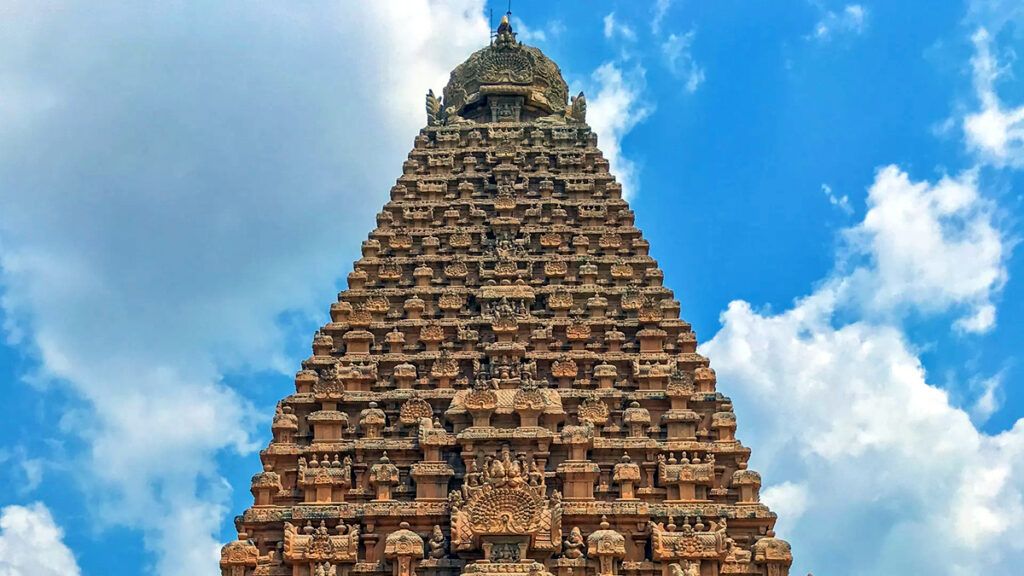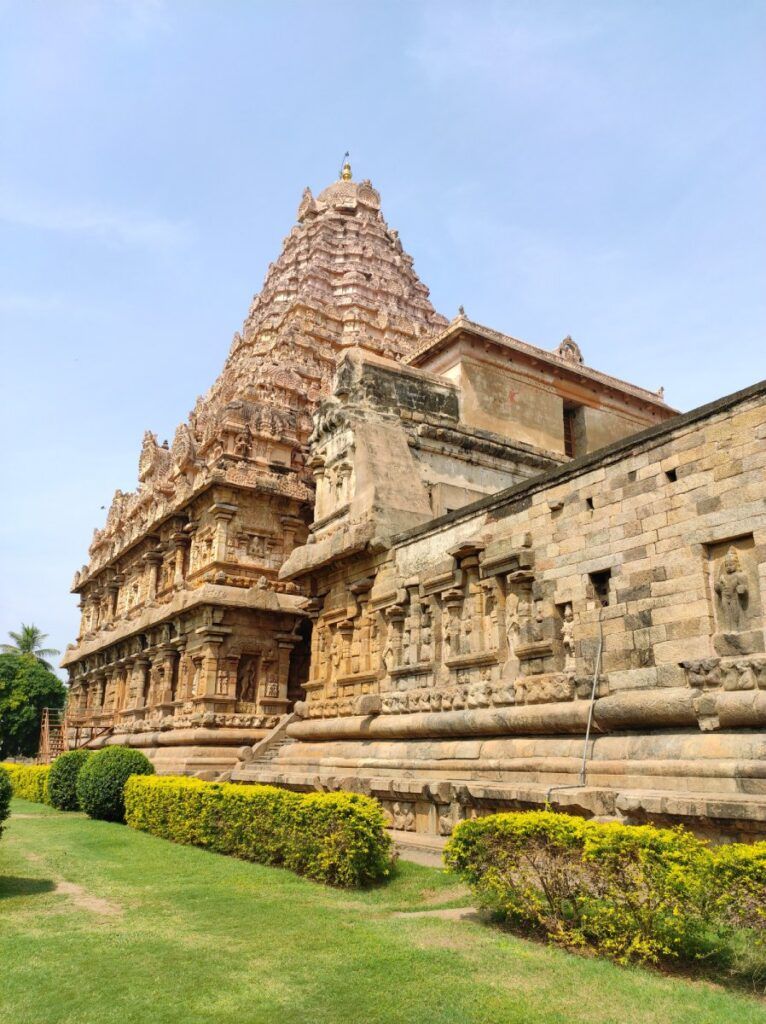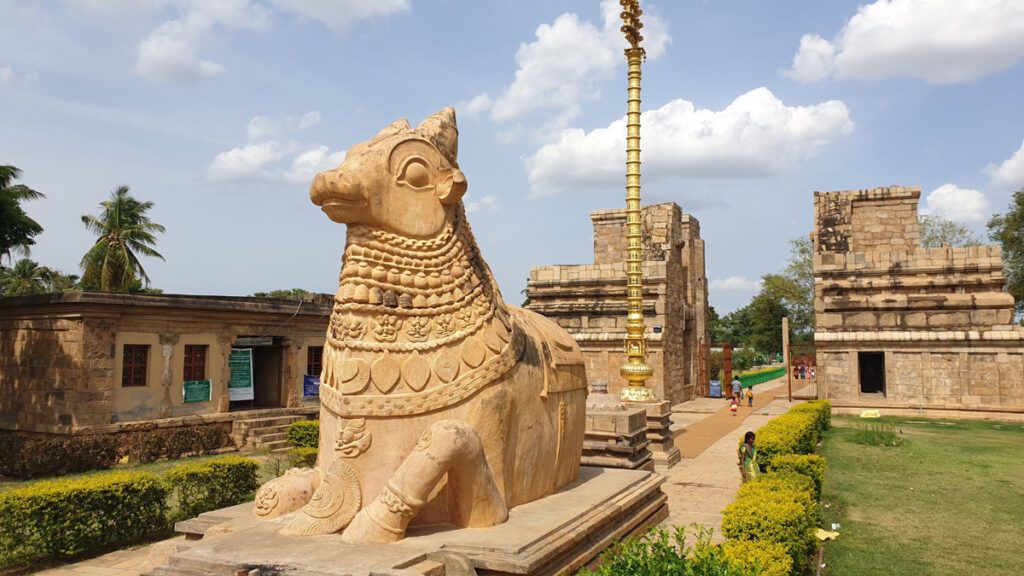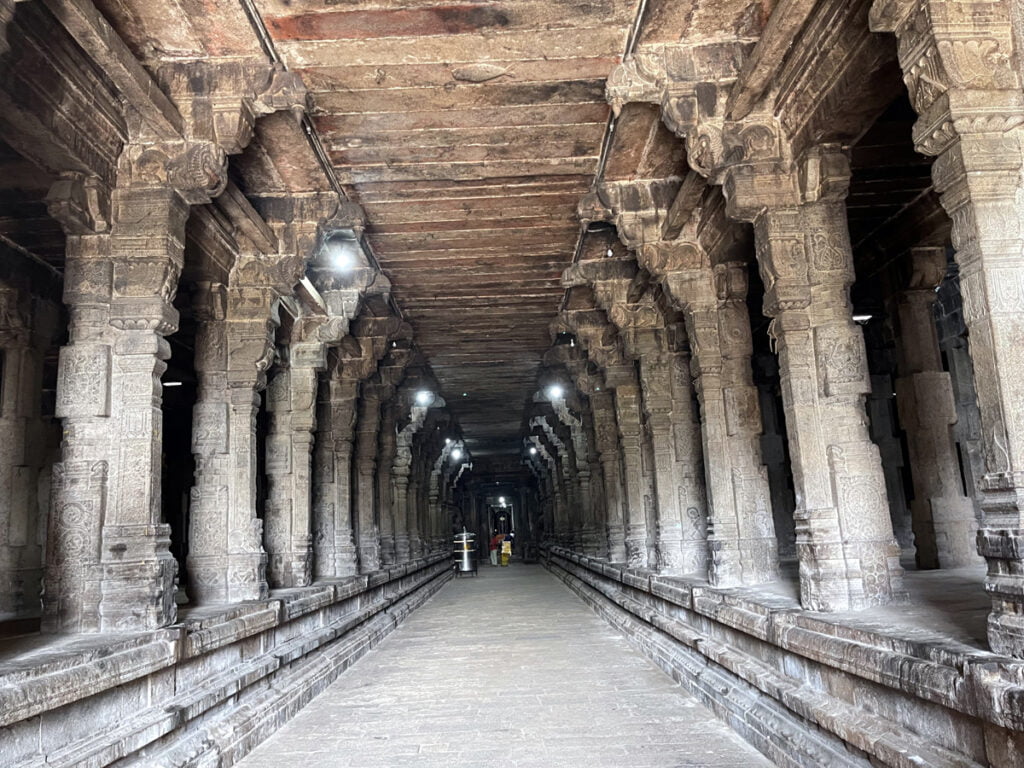Brihadeeswarar Temple: Timeless Marvel of Chola Architecture
Brihadeeswarar Temple, also known as the Peruvudaiyar Kovil or Rajarajeswaram Temple, is a magnificent Hindu temple located in Thanjavur (Tanjore), Tamil Nadu, India. It is dedicated to Lord Shiva and is renowned for its architectural grandeur and historical significance. Here is an overview of the history of the Brihadeeswarar Temple:

Contents
- 1 History of Brihadeeswarar Temple:
- 2 Brihadeeswarar Temple Architecture:
- 3 What is special about Brihadeeswarar Temple?
- 4 Why there is no shadow in Brihadeeswarar Temple?
- 5 Brihadeeswara Temple Timing:
- 6 Places to visit near Brihadeeswarar Temple:
- 7 FAQ:
- 7.0.1 What is the significance of the Brihadeeswara Temple?
- 7.0.2 Who built the Brihadeeswara Temple?
- 7.0.3 What is the architectural style of the temple?
- 7.0.4 What is the main deity of the temple?
- 7.0.5 What are the unique features of the Brihadeeswara Temple?
- 7.0.6 Is the Brihadeeswara Temple a UNESCO World Heritage Site?
- 7.0.7 Can visitors enter the temple complex?
- 7.0.8 What are the festivals celebrated at the Brihadeeswara Temple?
- 7.0.9 How to reach the Brihadeeswara Temple?
- 7.0.10 Is there an entrance fee for visiting the temple?
- 8 How to reach Brihadeeswarar Temple:
- 9 Google Maps:
History of Brihadeeswarar Temple:
Construction Period: The temple was built during the reign of the Chola emperor Rajaraja I (also known as Rajaraja the Great). The construction of the temple complex began around 1003 CE and was completed in 1010 CE. The temple was inaugurated by Rajaraja I himself.
Chola Dynasty: The Chola Dynasty was one of the most powerful and influential dynasties in South India. Rajaraja I was an ardent devotee of Lord Shiva and wanted to build a grand temple that would serve as a testament to his devotion and the glory of the Chola Dynasty.
Architectural Brilliance: The Brihadeeswarar Temple is a masterpiece of Dravidian architecture. The temple’s towering vimana (tower) is one of the tallest of its kind in the world. The temple complex includes a sanctum, pillared halls, a massive Nandi (bull) sculpture, and intricate sculptures and carvings that depict various mythological stories and scenes from daily life.
UNESCO World Heritage Site: In recognition of its historical and architectural significance, the Brihadeeswarar Temple was designated as a UNESCO World Heritage Site in 1987.
Cultural and Religious Importance: The temple not only served as a place of worship but also as a cultural and economic center during the Chola period. It attracted scholars, artisans, and pilgrims from various parts of the world.
Contributions of Rajaraja I: Rajaraja I is credited with not only building the Brihadeeswarar Temple but also for his administrative skills, military victories, and contributions to literature and culture. He established a well-organized administration that supported the temple’s maintenance and activities.
Legacy: The Brihadeeswarar Temple is considered an iconic symbol of Tamil architecture and Chola artistry. It continues to attract visitors, historians, and art enthusiasts from around the world.
Read More>> Enchanting Beauty of Madurai Meenakshi Amman Temple

Brihadeeswarar Temple Architecture:
- Vimana (Main Tower): The temple’s towering vimana, also known as the Rajagopuram, is one of its most distinctive features. Rising to a height of around 66 meters (216 feet), the vimana is an architectural marvel. It’s built from granite blocks stacked without the use of mortar. The vimana tapers as it rises, creating an imposing and visually striking structure.
- Nandi Mandapam: At the entrance of the temple stands a massive monolithic sculpture of Nandi, Lord Shiva’s sacred bull. This Nandi sculpture is about 3.7 meters (12 feet) tall and 6 meters (20 feet) long. It is carved from a single granite rock and sits in a pavilion adorned with intricate carvings.
- Sanctum and Shikhara: The main sanctum houses the deity, Lord Brihadeeswarar (Lord Shiva), in the form of a lingam. The sanctum is surrounded by a high pyramidal superstructure called the shikhara. The shikhara is a characteristic feature of Dravidian temples and is adorned with intricate sculptures depicting various deities and celestial beings.
- Mandapas (Halls): The temple complex includes multiple mandapas (pillared halls) for various purposes. The ardha mandapam serves as the entrance hall, leading to the mukha mandapam, where religious discourses and gatherings took place. The maha mandapam is a larger hall with intricately carved pillars and ceilings.
- Sculptures and Carvings: The Brihadeeswarar Temple is known for its intricate sculptures and carvings that adorn the walls, pillars, and ceilings. These carvings depict mythological stories, deities, celestial beings, dancers, musicians, animals, and scenes from daily life. The level of detail and artistry in the carvings is extraordinary.
- Frescoes: While many of the frescoes have faded over time, traces of vibrant paintings can still be seen on some walls. These paintings showcase scenes from Hindu mythology and narratives.
- Dravidian Elements: The temple’s architecture incorporates typical Dravidian features, including pyramidal towers, massive entrance gopurams, and intricately carved surfaces. The use of granite and the emphasis on verticality are also characteristic of Dravidian temple architecture.
- Symbolism: The entire temple complex is laden with symbolism related to Hindu cosmology, religious beliefs, and spiritual concepts.
Read More>> Char Dham Yatra – A Complete Guide to Spiritual Destination

What is special about Brihadeeswarar Temple?
The Brihadeeswarar Temple, also known as the Periya Kovil (Big Temple), is a Hindu temple dedicated to Lord Shiva located in Thanjavur, Tamil Nadu, India. It is one of the largest temples in India and is an exemplar of Dravidian architecture during the Chola period. Built by emperor Raja Raja Chola I and completed in 1010 AD, the temple turned 1000 years old in 2010. The temple is part of the UNESCO World Heritage Site known as the “Great Living Chola Temples”, along with the other two being the Brihadeeswarar Temple, Gangaikonda Cholapuram and Airavatesvara Temple.
Here are some of the things that make the Brihadeeswarar Temple special:
- It is one of the largest Hindu temples in the world, and the tallest in South India.
- It is a masterpiece of Dravidian architecture, with its soaring vimana (tower) and intricate carvings.
- It was built by Raja Raja Chola I, one of the most powerful and influential rulers in Indian history.
- It is home to a massive Shiva lingam, one of the largest in India.
- It is a UNESCO World Heritage Site, recognized for its outstanding universal value.
- The temple is said to have been built in just five years, which is a remarkable feat of engineering and construction for its time.
- The vimana of the temple is made of a single monolithic stone, weighing over 80 tons. It is believed that this stone was transported to the temple from a quarry over 60 kilometers away.
- The temple is known for its intricate carvings, which depict a variety of scenes from Hindu mythology, as well as everyday life during the Chola period.
- The temple complex also includes a number of other important structures, such as a large Nandi bull, a shrine to Parvati, and a mandapa (pavilion) where dancers and musicians would perform.
Read More>> Arupadai veedu | Six Abodes of Lord Murugan

Why there is no shadow in Brihadeeswarar Temple?
The Brihadeeswarar Temple in Thanjavur, India, is said to have no shadow. This is a popular myth, but it is not entirely true. The shadow of the temple does fall, but it falls within the temple complex, not outside of it.
There are a few possible explanations for this phenomenon. One possibility is that the angle of the sun at noon is such that the shadow of the temple falls on the walls or other structures of the temple complex. Another possibility is that the design of the temple, with its many towers and domes, creates a kind of optical illusion that makes it appear as if the temple has no shadow.
Whatever the explanation, the lack of a shadow at noon is one of the many mysteries of the Brihadeeswarar Temple. This magnificent temple is a UNESCO World Heritage Site and is one of the most important architectural and cultural monuments in India.
Here are some other possible explanations for the lack of shadow:
The temple is built on a raised platform, which may block the shadow from reaching the ground.
The temple is made of a very dark material, which absorbs more light and makes it less likely to cast a shadow.
The temple is located in a very sunny area, where the sun’s rays are very direct and do not create shadows.
It is also possible that the lack of shadow is simply a coincidence. The angle of the sun at noon can vary slightly from day to day, and it is possible that on some days the shadow of the temple does fall on the ground. However, the myth of the shadowless temple has persisted for centuries, and it continues to fascinate visitors to this day.
Read More>> Kashi Vishalakshi Temple Varanasi
Brihadeeswara Temple Timing:
Temple Opening Hours:
Morning: 6:00 AM to 12:30 PM
Evening: 4:00 PM to 8:30 PM

Places to visit near Brihadeeswarar Temple:
Thanjavur Palace: Also known as the Maratha Palace, this historical complex is located near the Brihadeeswarar Temple. It includes the Royal Museum, which houses a collection of art, artifacts, and relics from the Maratha dynasty.
Saraswathi Mahal Library: This library is known for its vast collection of ancient manuscripts, palm-leaf manuscripts, and historical documents. It’s a treasure trove of knowledge and history.
Schwartz Church: Built by the Danish missionary Christian Friedrich Schwartz, this church is one of the oldest Protestant churches in India. It’s known for its historical significance and serene ambiance.
Raja Serfoji Memorial Hall: This museum showcases a diverse collection of artifacts related to the Maratha dynasty, including weapons, costumes, paintings, and musical instruments.
Art Galleries: Thanjavur has several art galleries that exhibit traditional Tanjore paintings, a distinctive style of South Indian art known for its rich colors and embellishments.
Sangeetha Mahal: This palace is dedicated to music and dance and hosts performances, concerts, and cultural events. It’s a testament to the region’s artistic heritage.
Punnainallur Mariamman Temple: This temple dedicated to the goddess Mariamman is located a short distance from the Brihadeeswarar Temple. It’s a local religious site with its own historical significance.
Kumbakonam: If you’re willing to venture a bit farther, Kumbakonam is a nearby town known for its temples, cultural heritage, and traditional South Indian architecture.
Gangaikonda Cholapuram: This historic site is home to the Gangaikonda Cholapuram Temple, another architectural marvel built during the Chola dynasty. It’s a UNESCO World Heritage Site and is located a bit further from Thanjavur.
Swamimalai: This town is known for its Swaminathaswamy Temple dedicated to Lord Murugan. It’s located around 35 kilometers from Thanjavur and is famous for its association with learning and education.

FAQ:
What is the significance of the Brihadeeswara Temple?
The Brihadeeswara Temple is renowned for its architectural and cultural significance. It is one of the largest and most well-preserved temples in India, built during the Chola dynasty period (approximately 1010 AD) and dedicated to Lord Shiva.
Who built the Brihadeeswara Temple?
The temple was built by the Chola emperor Raja Raja I, also known as Rajaraja Chola, in the 11th century. It is a symbol of the Chola dynasty’s power and patronage of art and culture.
What is the architectural style of the temple?
The temple is a prime example of Dravidian architecture. It features a towering Vimana (pyramidal tower) that is over 66 meters high, with intricate carvings, and is constructed using granite stone.
What is the main deity of the temple?
The primary deity of the temple is Lord Shiva, in the form of a massive Shiva Lingam (a sacred symbol representing Lord Shiva).
What are the unique features of the Brihadeeswara Temple?
The temple is famous for its unique architectural features, including a massive Nandi (bull) sculpture, a grand courtyard, and a towering entrance gate, known as the Gopuram. The temple is also known for its intricate stone carvings.
Is the Brihadeeswara Temple a UNESCO World Heritage Site?
Yes, the temple is designated as a UNESCO World Heritage Site. It was added to the list in 1987 for its cultural and historical significance.
Can visitors enter the temple complex?
Yes, the temple is open to visitors, and it continues to be an active place of worship. However, there may be specific rules and dress codes that visitors need to follow when entering the temple.
What are the festivals celebrated at the Brihadeeswara Temple?
The temple hosts various festivals and rituals throughout the year. Maha Shivaratri is one of the most prominent festivals celebrated with great fervor.
How to reach the Brihadeeswara Temple?
The temple is located in Thanjavur, Tamil Nadu, and is easily accessible by road, rail, and air. The nearest airport is the Tiruchirapalli International Airport, and the nearest railway station is Thanjavur Junction.
Is there an entrance fee for visiting the temple?
Yes, there is an entrance fee for visitors, and the pricing may vary for domestic and international tourists. There might be additional fees for cameras and video equipment.
How to reach Brihadeeswarar Temple:
By Air:
The nearest major airport to Thanjavur is Tiruchirapalli International Airport (TRZ), which is approximately 60 kilometers away. From the airport, you can hire a taxi or use other local transportation options to reach the Brihadeeswarar Temple in Thanjavur.
By Train:
Thanjavur has a railway station (Thanjavur Junction) that is well-connected to various cities in India. You can take a train to Thanjavur and then use local transportation, such as auto-rickshaws or taxis, to reach the Brihadeeswarar Temple.
By Bus:
Thanjavur is well-connected by road networks, and you can reach the city by state-run buses, private buses, or even long-distance buses from nearby cities. The Brihadeeswarar Temple is a prominent landmark in Thanjavur, so many local transportation options can take you to the temple.
Local Transportation:
Within Thanjavur, you can use auto-rickshaws, cycle-rickshaws, and taxis to move around the city and visit the Brihadeeswarar Temple. The temple is a significant attraction in the city, and transportation options are readily available.
Guided Tours:
If you’re a tourist or unfamiliar with the city, joining a guided tour could be a convenient way to reach and explore the Brihadeeswarar Temple. Many tour operators offer guided tours that include transportation, a guide, and insights into the history and significance of the temple.

2 Comments